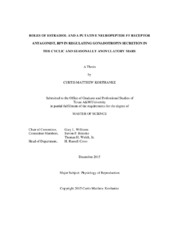| dc.description.abstract | Seasonal reproduction is highly correlated with circulating concentrations of luteinizing hormone (LH) in mares and low peripheral concentrations of LH serve as the primary basis for ovarian quiescence during the non-breeding season. Four experiments were conducted to investigate the effects and underlying relationships of 1-adamantanecarbonyl-RF-NH2 (RF9) and estradiol in the regulation of LH secretion. During the luteal phase of the estrous cycle (Experiment 1), mares were treated with two bolus intravenous injections of RF9 (0.2 and 0.4 mg/kg, respectively) within a 1-h interval to determine effects on secretion of gonadotropin-releasing hormone (GnRH), follicle-stimulating hormone (FSH) and luteinizing hormone (LH). Dose-dependent increases (P < 0.05) in both FSH and LH concentrations in response to RF9 were observed. Due to an inability to validate the GnRH radioimmunoassay, changes in secretion of GnRH could not be determined. In Experiment 2, the effect of estradiol-17β (estradiol) pretreatment on responsiveness to RF9 was examined in winter anovulatory mares. Mares received a single intramuscular injection of corn oil of 5 mg estradiol in corn oil followed by a bolus injection of RF9 18 h later. Estradiol pretreatment increased (P < 0.05) peak concentrations of LH in response to RF9. The half-life of RF9 in the circulation of the mare following peripheral administration was determined in Experiment 3 using liquid chromatography and mass spectrometry. Intravenously-injected RF9 was rapidly removed from the mare’s circulatory system; exhibiting a half-life of approximately 40 min. Finally, the role of estradiol and its interaction with GnRH in regulating secretion of LH in anovulatory mares during increasing photoperiod was examined. In February, mares were assigned to 1 of 4 groups and served as controls
(corn oil injections) or received 1 of 3 treatments: daily i.m. injections of estradiol in corn oil for 14 d, continuous subcutaneous treatment with native GnRH for 14 d at a rate of 100 µg/h, or the estradiol and GnRH treatments in combination. Estradiol alone had no effect on secretion of LH but markedly enhanced (P < 0.0002) responsiveness to GnRH. Due to its short half-life, RF9 may not be useful therapeutically; however, estradiol enhances responsiveness to GnRH and may be useful in treatments designed to accelerate vernal transition. | en |


